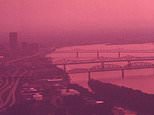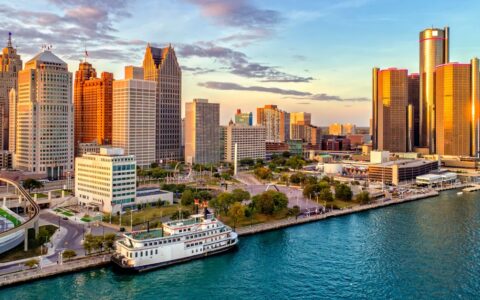
Shocking images reveal how pollution plagued America’s skies, rivers and highways before the Environmental Protection Agency (EPA) was founded in the 1970s.
The agency commissioned the stark photos shortly after it formed to prove the US sorely needed its services, including the Clean Air and Water Acts.
The gallery shows raw sewage flowed into the Potomac River near the White House, heavy smog engulfed New York City’s George Washington Bridge and Oregon forests ravaged by droughts.
The populated cities have since cleaned up their acts since the EPA-mandated pollution regulations and now look nearly unrecognizable 30 years later.
New York City’s George Washington Bridge, enveloped in heavy smog and photographed with a view toward New Jersey in 1973 (left). While the city today is polluted, it is nowhere near the levels experienced 30 years ago
Shortly after Republican President Richard Nixon created the EPA via executive order in 1970, the agency set about cleaning up the nation and documenting the scope of America’s mess.
Beginning in 1971, the EPA commissioned by more than 100 professional photographers to document the American landscape using 40 rolls of film each.
The photographers set out across the coal mines, landfills and manufacturing zones of the then-industrial US, as well as traversing deserts and farmland and exploring the nooks and crannies of the big cities.
The result was a collection of more than 22,000 photographs of the country’s environmental problems captured over a period of six years, a project the agency dubbed ‘Documerica.’
A total of 15,000 images of the venture are available online.
The concept was the brainchild of the EPA’s first public information officer, Gifford Dean Hampshire, a Kansas native and former editor for National Geographic.
Raw sewage flows into the Potomac River yards away from Washington DC’s infamous Watergate Complex in April 1973 (left) and today the water appears much cleaner
Baltimore City did have some simple techniques to keep the harbor clean. Here, a screen has been placed across the water to trap trash. Modern technology has brought the city a robot (right) to clean up the river
A 1973 drought in Oregon’s Marion County revealed the historic ravages of logging across the shores of Marion’s Detroit Lake, in this image by ‘Documerica’ contributor David Falconer
Hampshire was inspired by Depression-era photography programs that conveyed the struggles of poor rural farmers to their fellow Americans, according to his 2004 obituary.
‘Documerica’ took that 1930s work by the Farm Security Administration, covering economic hardship and the Dust Bowl, as a model for its own efforts.
‘Documerica’ captured the nation’s landscape at a time before water and air pollution were not yet fully regulated. Despite prior attempts in Congress, the Clean Air Act and the Clean Water Act did not really acquire teeth until the early 1970s.
The EPA was born in the US where rampant pollution made it unsafe for its citizens to fish or swim in many of the nation’s rivers and thick air pollution hid the iconic skylines of major cities from New York to San Francisco.
Smog catches the sunlight in Louisville, Kentucky, creating a purple haze over the city’s Ohio River bridges in September 1972. A recent image snapped in 2021 shows clear blue skies
Cloudy, orange sewage discharged by Denver’s Metro Sewage Treatment Plant seeps into the South Platte River in this photo by Bruce McAllister for the EPA
Before the Clean Air Act was passed in 1970, soot and smog engulfed Birmingham, Alabama, earning it the nickname ‘Smoke City.’ This image was taken in July 1972
The Atlas Chemical Company plant in Texas, nicknamed ‘Old Darky,’ pours smoke into the air near a Harrison county pasture in this June 1972. The plant has since closed
Between 2011 and 2013, the EPA revived its old ‘Documerica’ mandate with a crowdsourced State of the Environment (SotE) Photo Project. The agency invited the members of the public to submit their own photos documenting environmental conditions across the nation.
Both these crowdsourced images and the professional photography of ‘Documerica’ help the American public track their nation’s relationship to the natural world upon which it was built.
Last week’s gripping images of sepia-toned smoke that blanketing America’s northeastern seaboard, a consequence of climate change’s impact on Canada’s record-smashing summer wildfires, now join these pics as a new record of a new era.
On June 7, New York City was more than 56 times over the World Health Organization’s safety limit, making it the world’s most polluted.
The air quality index (AQI) is at 353 – 500 is the highest – compared to 15 on June 3.
These measurements are taken by converting measured pollutant concentrations to a uniform index based on the health effects associated with a pollutant.
Swaths of wildfire smoke came blowing into New York City this week, but on Wednesday, the sky turned an ominous orange from toxic nanoparticles.
Source link
CHECK OUT: Top Travel Destinations
READ MORE: Travel News



